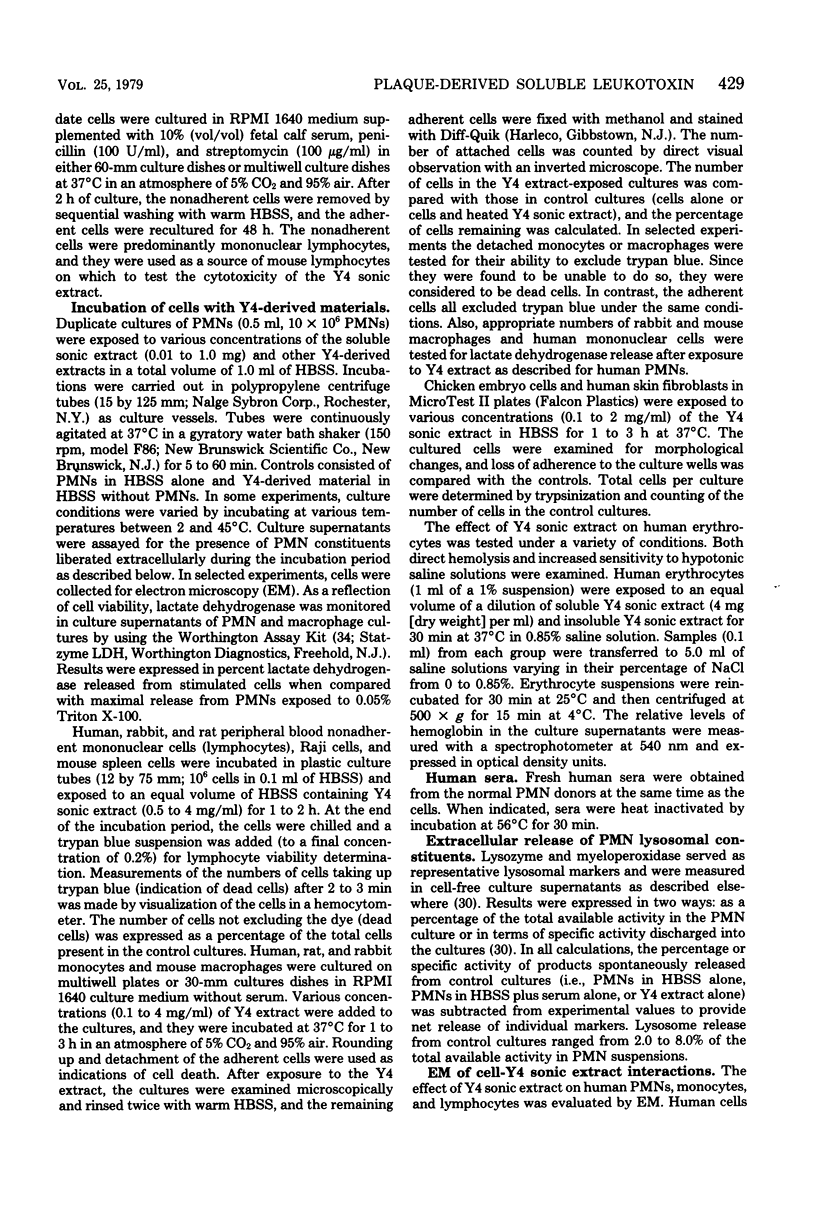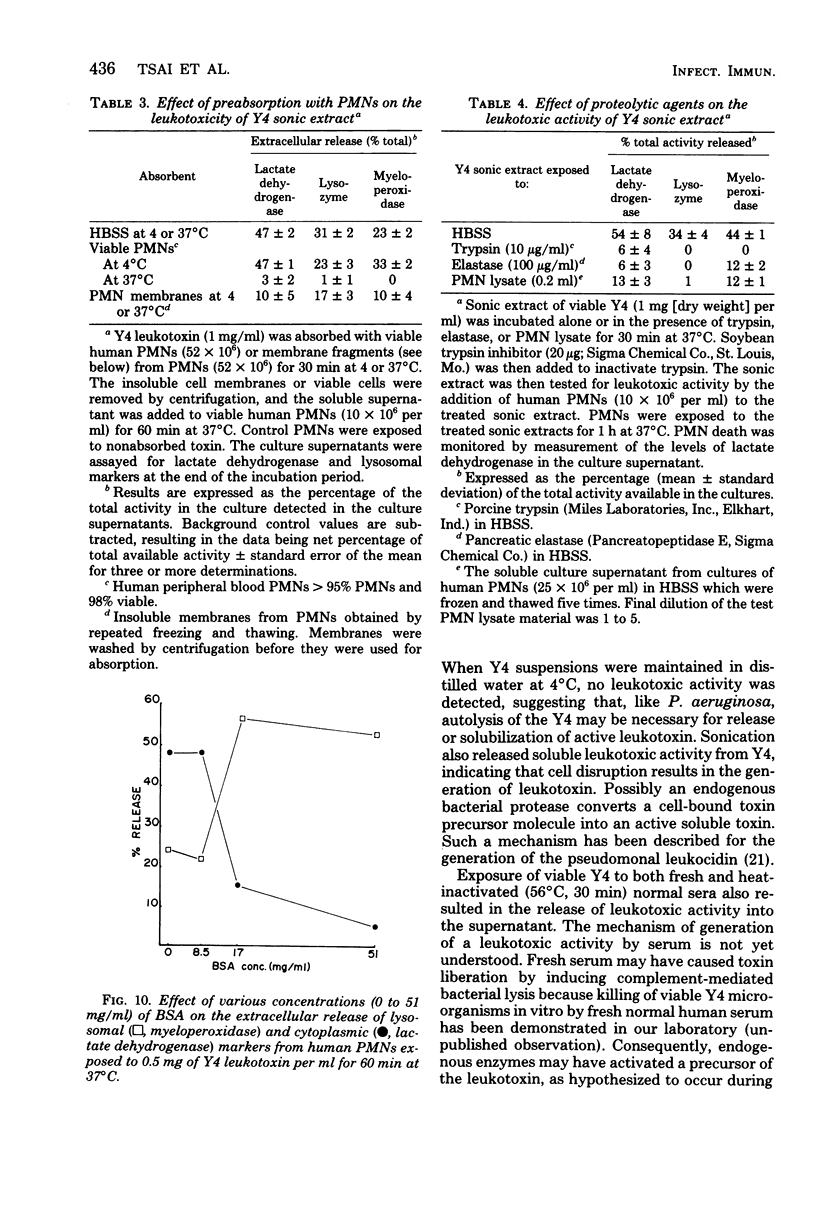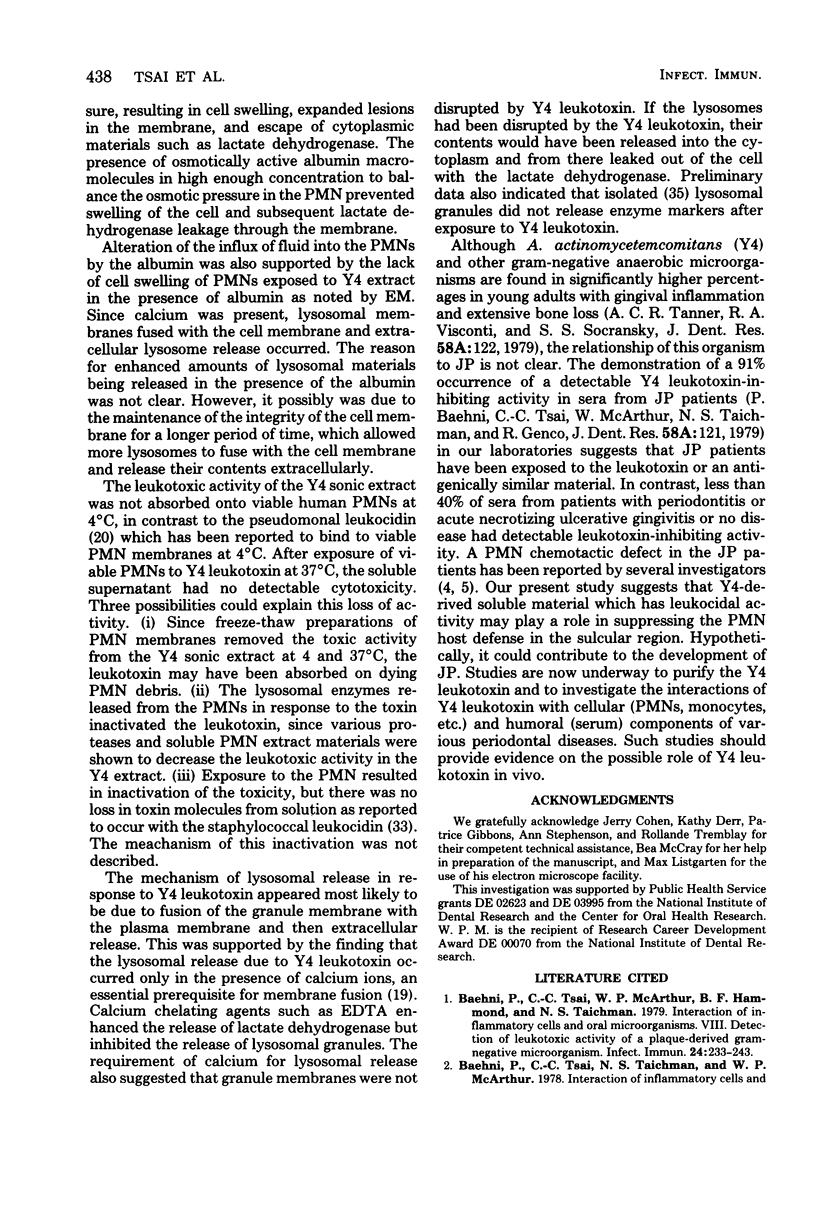Abstract
The plaque-derived gram-negative microorganism Y4 identified as a member of the genus Actinobacillus, was tested for a soluble cytotoxic factor(s). Sonication or incubation of viable Y4 microorganisms in distilled water or normal human serum resulted in liberation of a soluble material which was cytotoxic in vitro for human polymorphonuclear leukocytes (PMNs). The Y4 soluble sonic extract was also cytotoxic to human peripheral blood monocytes. However, human lymphocytes, platelets, and fibroblasts, as well as rabbit, rat, and mouse leukocytes and chicken embryo fibroblasts, were not killed by exposure to the Y4 sonic extract. No hemolytic activity was detected in the Y4 sonic extract. No hemolytic activity was detected in the Y4 sonic extract. Consequently, the factor(s) in the Y4 sonic extract was referred to as Y4 leukotoxin. The Y4 leukotoxin was inactive at 4 degrees C, heat sensitive (56 degrees C, 30 min), and inactivated by proteases. The cytotoxic effect of Y4 leukotoxin on PMNs was dose, time, and temperature dependent. The leukotoxin did not bind to viable PMNs at 4 degrees C but did bind to dead PMN membrane components at both 4 and 37 degrees C. The addition of bovine serum albumin (51 mg/ml) to PMN-Y4 leukotoxin cultures inhibited the release of lactate dehydrogenase from the PMNs, but did not prevent the death of the cells as indicated by electron microscopy. Lysosomal markers were released in parallel to the cytoplasmic enzyme lactate dehydrogenase from Y4 leukotoxin-treated PMNs. The addition of 0.02 M ethylenedinitrilotetraacetic acid to these cultures inhibited release of lysosomal markers but enhanced the release of lactate dehydrogenase. These results suggested that a soluble leukotoxin with specificity for only human PMNs and monocytes can be liberated from viable Y4. What role this leukotoxin plays in the pathogenicity of the Y4 microorganism is not yet known. However, this leukotoxin is one of the first materials from a plaque-derived microorganism with a potential role in the pathogenesis of juvenile periodontitis.
Full text
PDF












Images in this article
Selected References
These references are in PubMed. This may not be the complete list of references from this article.
- Baehni P., Tsai C. C., McArthur W. P., Hammond B. F., Taichman N. S. Interaction of inflammatory cells and oral microorganisms. VIII. Detection of leukotoxic activity of a plaque-derived gram-negative microorganism. Infect Immun. 1979 Apr;24(1):233–243. doi: 10.1128/iai.24.1.233-243.1979. [DOI] [PMC free article] [PubMed] [Google Scholar]
- Baehni P., Tsai C. C., Taichman N. S., McArthur W. Interaction of inflammatory cells and oral microorganisms. V. Electron microscopic and biochemical study on the mechanisms of release of lysosomal constituents from human polymorphonuclear leukocytes exposed to dental plaque. J Periodontal Res. 1978 Jul;13(4):333–348. doi: 10.1111/j.1600-0765.1978.tb00188.x. [DOI] [PubMed] [Google Scholar]
- Baer P. N. The case for periodontosis as a clinical entity. J Periodontol. 1971 Aug;42(8):516–520. doi: 10.1902/jop.1971.42.8.516. [DOI] [PubMed] [Google Scholar]
- Cainciola L. J., Genco R. J., Patters M. R., McKenna J., van Oss C. J. Defective polymorphonuclear leukocyte function in a human periodontal disease. Nature. 1977 Feb 3;265(5593):445–447. doi: 10.1038/265445a0. [DOI] [PubMed] [Google Scholar]
- Clark R. A., Page R. C., Wilde G. Defective neutrophil chemotaxis in juvenile periodontitis. Infect Immun. 1977 Dec;18(3):694–700. doi: 10.1128/iai.18.3.694-700.1977. [DOI] [PMC free article] [PubMed] [Google Scholar]
- Freedman H. L., Listgarten M. A., Taichman N. S. Electron microscopic features of chronically inflamed human gingiva. J Periodontal Res. 1968;3(4):313–327. doi: 10.1111/j.1600-0765.1968.tb01937.x. [DOI] [PubMed] [Google Scholar]
- Gibbons R. J., Houte J. V. Bacterial adherence in oral microbial ecology. Annu Rev Microbiol. 1975;29:19–44. doi: 10.1146/annurev.mi.29.100175.000315. [DOI] [PubMed] [Google Scholar]
- Irving J. T., Newman M. G., Socransky S. S., Heely J. D. Histological changes in experimental periodontal disease in rats mono-infected with a gram-negative organism. Arch Oral Biol. 1975 Mar;20(3):219–220. doi: 10.1016/0003-9969(75)90013-8. [DOI] [PubMed] [Google Scholar]
- Kelstrup J., Theilade E. Microbes and periodontal disease. J Clin Periodontol. 1974;1(1):15–35. doi: 10.1111/j.1600-051x.1974.tb01235.x. [DOI] [PubMed] [Google Scholar]
- LISTGARTEN M. A. ELECTRON MICROSCOPIC OBSERVATIONS ON THE BACTERIAL FLORA OF ACUTE NECROTIZING ULCERATIVE GINGIVITIS. J Periodontol. 1965 Jul-Aug;36:328–339. doi: 10.1902/jop.1965.36.4.328. [DOI] [PubMed] [Google Scholar]
- LOE H., THEILADE E., JENSEN S. B. EXPERIMENTAL GINGIVITIS IN MAN. J Periodontol. 1965 May-Jun;36:177–187. doi: 10.1902/jop.1965.36.3.177. [DOI] [PubMed] [Google Scholar]
- Lehner T., Wilton J. M., Ivanyi L., Manson J. D. Immunological aspects of juvenile periodontitis (periodontosis). J Periodontal Res. 1974;9(5):261–272. doi: 10.1111/j.1600-0765.1974.tb00681.x. [DOI] [PubMed] [Google Scholar]
- Listgarten M. A. Structure of the microbial flora associated with periodontal health and disease in man. A light and electron microscopic study. J Periodontol. 1976 Jan;47(1):1–18. doi: 10.1902/jop.1976.47.1.1. [DOI] [PubMed] [Google Scholar]
- Manson J. D., Lehner T. Clinical features of juvenile periodontitis (periodontosis). J Periodontol. 1974 Aug;45(8):636–640. doi: 10.1902/jop.1974.45.8.2.636. [DOI] [PubMed] [Google Scholar]
- Newman M. G., Socransky S. S. Predominant cultivable microbiota in periodontosis. J Periodontal Res. 1977 Mar;12(2):120–128. doi: 10.1111/j.1600-0765.1977.tb00114.x. [DOI] [PubMed] [Google Scholar]
- Newman M. G., Socransky S. S., Savitt E. D., Propas D. A., Crawford A. Studies of the microbiology of periodontosis. J Periodontol. 1976 Jul;47(7):373–379. doi: 10.1902/jop.1976.47.7.373. [DOI] [PubMed] [Google Scholar]
- Page R. C., Schroeder H. E. Pathogenesis of inflammatory periodontal disease. A summary of current work. Lab Invest. 1976 Mar;34(3):235–249. [PubMed] [Google Scholar]
- Poste G., Allison A. C. Membrane fusion. Biochim Biophys Acta. 1973 Dec 28;300(4):421–465. doi: 10.1016/0304-4157(73)90015-4. [DOI] [PubMed] [Google Scholar]
- Scharmann W. Formation and isolation of leucocidin from Pseudomonas aeruginosa. J Gen Microbiol. 1976 Apr;93(2):283–291. doi: 10.1099/00221287-93-2-283. [DOI] [PubMed] [Google Scholar]
- Scharmann W., Jacob F., Porstendörfer J. The cytotoxic action of leucocidan from Pseudomonas aeruginosa on human polymorphonuclear leucocytes. J Gen Microbiol. 1976 Apr;93(2):303–308. doi: 10.1099/00221287-93-2-303. [DOI] [PubMed] [Google Scholar]
- Scharmann W. Purification and characterization of leucocidin from Pseudomonas aeruginosa. J Gen Microbiol. 1976 Apr;93(2):292–302. doi: 10.1099/00221287-93-2-292. [DOI] [PubMed] [Google Scholar]
- Slots J. The predominant cultivable organisms in juvenile periodontitis. Scand J Dent Res. 1976 Jan;84(1):1–10. doi: 10.1111/j.1600-0722.1976.tb00454.x. [DOI] [PubMed] [Google Scholar]
- Socransky S. S., Manganiello A. D., Propas D., Oram V., van Houte J. Bacteriological studies of developing supragingival dental plaque. J Periodontal Res. 1977 Mar;12(2):90–106. doi: 10.1111/j.1600-0765.1977.tb00112.x. [DOI] [PubMed] [Google Scholar]
- Socransky S. S. Microbiology of periodontal disease -- present status and future considerations. J Periodontol. 1977 Sep;48(9):497–504. doi: 10.1902/jop.1977.48.9.497. [DOI] [PubMed] [Google Scholar]
- Socransky S. S. Relationship of bacteria to the etiology of periodontal disease. J Dent Res. 1970 Mar-Apr;49(2):203–222. doi: 10.1177/00220345700490020401. [DOI] [PubMed] [Google Scholar]
- Sterberg S. K., Sudo S. Z., Folke L. E. Microbial succession in subgingival plaque of man. J Periodontal Res. 1976 Sep;11(5):243–255. doi: 10.1111/j.1600-0765.1976.tb00078.x. [DOI] [PubMed] [Google Scholar]
- Taichman N. S., McArthur W. P. Interaction of inflammatory cells and oral bacteria: release of lysosomal hydrolases from rabbit polymorphonuclear leukocytes exposed to gram-positive plaque bacteria. Arch Oral Biol. 1976;21(4):257–263. doi: 10.1016/0003-9969(76)90044-3. [DOI] [PubMed] [Google Scholar]
- Taichman N. S., Tsai C. C., Baehni P. C., Stoller N., McArthur W. P. Interaction of inflammatory cells and oral microorganisms. IV. In vitro release of lysosomal constituents from polymorphonuclear leukocytes exposed to supragingival and subgingival bacterial plaque. Infect Immun. 1977 Jun;16(3):1013–1023. doi: 10.1128/iai.16.3.1013-1023.1977. [DOI] [PMC free article] [PubMed] [Google Scholar]
- Williams B. L., Pantalone R. M., Sherris J. C. Subgingival microflora and periodontitis. J Periodontal Res. 1976 Feb;11(1):1–18. doi: 10.1111/j.1600-0765.1976.tb00045.x. [DOI] [PubMed] [Google Scholar]
- Wright D. G., Gallin J. I. A functional differentiation of human neutrophil granules: generation of C5a by a specific (secondary) granule product and inactivation of C5a by azurophil (primary) granule products. J Immunol. 1977 Sep;119(3):1068–1076. [PubMed] [Google Scholar]








